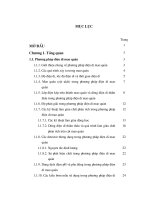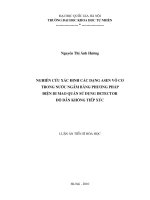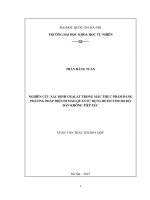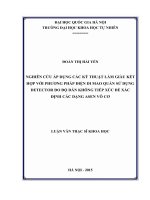DSpace at VNU: Nghiên cứu quy trình phân tích hợp phần As III trong nước ngầm bằng phương pháp điện di mao quản sử dụng detector độ dẫn không tiếp xúc
Bạn đang xem bản rút gọn của tài liệu. Xem và tải ngay bản đầy đủ của tài liệu tại đây (836.56 KB, 9 trang )
Nghiên cứu quy trình phân tích hợp phần As
III trong nước ngầm bằng phương pháp điện di
mao quản sử dụng detector độ dẫn không tiếp
xúc
Nguyễn Kim Diễm Mai
Trường Đại học Khoa học Tự nhiên
Luận văn ThS Chuyên ngành: Hóa môi trường; Mã số 60 44 01 20
Người hướng dẫn: TS. Dương Hồng Anh
Năm bảo vệ: 2013
Abstract. Xây dựng quy trình phân tích tiểu phân As(III) trong nước ngầm. Tối ưu
hóa các điều kiện phân tích As(III) trong nước ngầm bao gồm: pha động điện di, thời
gian bơm mẫu, hiệu điện thế tách, quy trình xử lý mẫu,… Khảo sát ảnh hưởng của các
ion nền cơ bản như: Cl-, SO42-, PO43-, NO2-, HCO3-, Fe2+ và đề xuất hướng giải
quyết trong trướng hợp ảnh hưởng đến kết quả đo. Áp dụng phương pháp nghiên cứu
để xác định hàm lượng As(III) trong một số mẫu nước giếng khoan và so sánh kết quả
thu được với phương pháp quang phổ hấp thụ nguyên tử kết hợp với thiết bị hidrua
hóa (HVG-AAS).
Keywords. Hóa học môi trường; Phương pháp điện di mao quản; Asen; Xử lý nước
ngầm.
MỞ ĐẦU
Trong vài chục năm trở lại đây, nƣớc ngầm đƣợc sử dụng rất phổ biến cho nhu
cầu ăn uống, sinh hoạt của ngƣời dân Việt Nam, đặc biệt tại các vùng đồng bằng, đô
thị đông dân cƣ. Tuy nhiên, nhiều nghiên cứu đã cho thấy nƣớc ngầm tại một số khu
vực có hàm lƣợng asen, mangan, amoni,… cao hơn tiêu chuẩn cho phép trong nƣớc
sinh hoạt. Trong số các chất kể trên thì asen là nguyên tố có độc tính cao, sự tích lũy
asen vào cơ thể trong thời gian dài kể cả ở hàm lƣợng thấp cũng gây nên nhiều tác
hại nghiêm trọng cho sức khỏe nhƣ: ung thƣ da, ung thƣ phổi, các bệnh ở gan, bàng
quang,….
Ngày nay, ô nhiễm asen trong nƣớc ngầm đang là vấn đề thu hút sự quan tâm
của các nhà khoa học trên thế giới. Ở Băngladet và Ấn Độ có khoảng 36 triệu ngƣời
đang đối mặt với nguy cơ về sức khỏe có liên quan đến nhiễm độc asen. Đồng thời,
nguồn nƣớc ngầm ở một số địa phƣơng ở nƣớc ta nhƣ: Hà Nam, Hà Tây, Hƣng
Yên,…cũng bị ô ngiễm As nghiêm trọng [14]. Do đó việc định lƣợng asen trong
nƣớc ngầm bằng các phƣơng pháp có độ chính xác cao và dễ áp dụng ở mọi nơi là
vô cùng cần thiết.
Cùng với các nghiên cứu khác, đề tài “Nghiên cứu quy trình phân tích hợp
phần asen III trong nước ngầm bằng phương pháp điện di mao quản sử dụng
detector độ dẫn không tiếp xúc” mong muốn đóng góp một phần vào việc xây
dựng một bức tranh chung về hiện tƣợng ô nhiễm asen trong nƣớc ngầm ở nƣớc ta
và giúp các nhà quản lí đề ra các biện pháp nhằm ngăn ngừa và giảm thiểu nguy cơ
phơi nhiễm asen của ngƣời dân. Áp dụng kĩ thuật phân tích điện di mao quản là một
hƣớng tiếp cận khá mới về phƣơng pháp phân tích As(III). Sau các thành công đã
đạt đƣợc trong luận văn này, hy vọng rằng có thể phát triển phƣơng pháp vào mục
đích chế tạo thiết bị phân tích As(III) hiện trƣờng, phục vụ cho việc phân tích nhanh
một lƣợng lớn mẫu nƣớc ngầm tại các hộ dân với độ đúng, độ lặp lại, giới hạn phát
hiện và giới hạn định lƣợng thỏa mãn QCVN cho phép đối với nƣớc ngầm là
50g/L.
x
TÀI LIỆU THAM KHẢO
Tiếng Việt
1.
Lê Huy Bá (2006), Độc học môi trường tập 2, Nhà xuất bản Đại học Quốc
gia, Tp.HCM.
2.
Nguyễn Thị Ánh Hƣờng (2010), Nghiên cứu xác định các dạng asen vô cơ
trong nước ngầm bằng phương pháp điện di mao quản sử dụng
đetectơ độ dẫn không tiếp xúc, Trƣờng Đại học Khoa học Tự Nhiên Đại học Quốc gia Hà Nội, Luận án Tiến sĩ Hóa học.
3.
Nguyễn Việt Kỳ (2009), "Tình hình ô nhiễm arsen ở đồng bằng sông Cƣu
Long", Tạp chí Phát triển Khoa học và Công nghệ, 12(5), pp. 101112.
4.
Hoàng Thái Long (2011), Nghiên cứu xác định lượng vết Asen trong môi
trường nước bằng phương pháp Von-Ampe hòa tan, Trƣờng Đại học
Khoa học Tự nhiên - Đại học Quốc Gia Hà Nội, Luận án Tiến Sĩ Hóa
học.
5.
Từ Văn Mặc, Nguyễn Trọng Biểu (2002), Thuốc thử hữu cơ, Nhà xuất bản
Khoa học-Kỹ thuật, Hà Nội.
6.
Nguyễn Ngọc Mai (2011), Nghiên cứu sự phân bố không đồng nhất về hàm
lượng As trong nước ngầm trên một phạm vi hẹp. Minh họa tại xã Vạn
Phúc, Thanh Trì, Hà Nội, Trƣờng Đại học Khoa học Tự Nhiên - Đại
học Quốc gia Hà Nội, Luận văn Thạc sĩ Khoa học.
7.
Bùi Thị Nga, Lê Văn Mƣời, Phạm Việt Nữ. (2011), "Ô nhiễm Arsen trong
nƣớc mặt ở đồng bằng sông Cửu Long", Tạp chí Khoa học trường Đại
học Cần Thơ, 18, pp. 183-192.
8.
Hoàng Nhâm (1999), Hóa học Vô cơ tập 2 - Các nguyên tố hóa học điển
hình, Nhà xuất bản giáo dục, Hà Nội.
9.
Tạ Thị Thảo, Chu Xuân Anh, Đỗ Quang Trung, Trần Văn Cƣờng. (2005),
"Nghiên cứu các phƣơng pháp trắc quang xác định lƣợng vết asen",
Tạp chí phân tích Hóa, Lý và Sinh học, 10(4), pp. 46-52.
76
10.
Tạ Thị Thảo (2010), Giáo trình thống kê trong Hóa phân tích, Trƣờng Đại
học Khoa học Tự nhiên - Đại học Quốc gia, Hà Nội.
11.
Phạm Thị Thanh Thủy (2009), Phân tích riêng rẽ các tiểu phần asen vô cơ As(III) và As(V) trong nước ngầm sử dụng phương pháp điện đ mao
quản, Trƣờng Đại học Khoa học Tự Nhiên - Đại học Quốc Gia Hà
Nội, Luận văn Thạc sĩ Khoa học.
12.
UNICEF (2004), Ô nhiễm thạch tín trong nguồn nước sinh hoạt ở Việt Nam Khái quát tình hình & các biện pháp giảm thiểu cần thiết, UNICEF
Việt Nam, Hà Nội.
Tiếng Anh
13.
Beck, W. and H. Engelhardt. (1992), "Capillary electrophoresis of organic
and inorganic cations with indirect UV detection", Chromatographia,
33(7-8), pp. 313-316.
14.
Berg, M., et al. (2001), "Arsenic Contamination of Groundwater and
Drinking Water in Vietnam: A Human Health Threat", Environmental
Science & Technology, 35(13), pp. 2621-2626.
15.
Berg, M., et al. (2008), "Hydrological and sedimentary controls leading to
arsenic contamination of groundwater in the Hanoi area, Vietnam: The
impact of iron-arsenic ratios, peat, river bank deposits, and excessive
groundwater abstraction", Chemical Geology, 249(1), pp. 91-112.
16.
Creed, J. (1997), "Speciation of Arsenic Compounds in Drinking Water by
Capillary
Electrophoresis
Electroosmotic
Flow
with
Detected
Hydrodynamically
Through
Hydride
Modified
Generation
Inductively Coupled Plasma Mass Spectrometry With a Membrane
Gas–Liquid Separator", Journal of Analytical Atomic Spectrometry,
12(7), pp. 689-695.
77
17.
Debusschere, L., C. Demesmay, and J. Rocca. (2000), "Arsenic speciation by
coupling capillary zone electrophoresis with mass spectrometry",
Chromatographia, 51(5-6), pp. 262-268.
18.
DeFrancesco, L. (2001), "Product Review: Capillary Electrophoresis:
Finding a Niche", Analytical chemistry, 73(17), pp. 497 A-499 A.
19.
Doušová, B., et al. (2006), "Sorption of AsV on aluminosilicates treated with
FeII nanoparticles", Journal of Colloid and Interface Science, 302(2),
pp. 424-431.
20.
Hanh, P.T.M., et al. (2010), "Anthropogenic influence on surface water
quality of the Nhue and Day sub-river systems in Vietnam",
Environmental geochemistry and health, 32(3), pp. 227-236.
21.
Kaniansky, D., et al. (1999), "Capillary electrophoresis of inorganic anions",
Journal of Chromatography A, 834(1), pp. 133-178.
22.
Kappes, T., et al. (2001), "Portable capillary electrophoresis instrument with
amperometric, potentiometric and conductometric detection", TrAC
Trends in Analytical Chemistry, 20(3), pp. 133-139.
23.
Kappes, T. and P.C. Hauser. (1999), "Electrochemical detection methods in
capillary electrophoresis and applications to inorganic species",
Journal of Chromatography A, 834(1), pp. 89-101.
24.
Kevin D.Altria. (1996), Capillary electrophoresis guidebook: Principle,
Operation and Applications, Humania press publishers.
25.
Kitagawa, F., K. Shiomi, and K. Otsuka. (2006), "Analysis of arsenic
compounds by capillary electrophoresis using indirect UV and mass
spectrometric detections", Electrophoresis, 27(11), pp. 2233-2239.
26.
Kubáň, P. and P.C. Hauser. (2004), "Contactless conductivity detection in
capillary electrophoresis: a review", Electroanalysis, 16(24), pp.
2009-2021.
78
27.
Kubáň, P. and P.C. Hauser. (2009), "Fundamentals of electrochemical
detection techniques for CE and MCE", Electrophoresis, 30(19), pp.
3305-3314.
28.
Kubáň, P., P. Kubáň, and V. Kubáň. (2003), "Speciation of chromium (III)
and chromium (VI) by capillary electrophoresis with contactless
conductometric
detection
and
dual
opposite
end
injection",
Electrophoresis, 24(9), pp. 1397-1403.
29.
Kuhr, W.G. and E.S. Yeung. (1988), "Optimization of sensitivity and
separation in capillary zone electrophoresis with indirect fluorescence
detection", Analytical Chemistry, 60(23), pp. 2642-2646.
30.
Lemos, N.P., et al. (2001), "Capillary electrophoresis: a new tool in forensic
medicine and science", Science & Justice, 41(3), pp. 203-210.
31.
Li, F., et al. (2005), "Speciation analysis of inorganic arsenic by microchip
capillary electrophoresis coupled with hydride generation atomic
fluorescence spectrometry", Journal of chromatography A, 1081(2),
pp. 232-237.
32.
Liu, Y., et al. (1995), "Capillary electrophoresis coupled online with
inductively coupled plasma mass spectrometry for elemental
speciation", Analytical Chemistry, 67(13), pp. 2020-2025.
33.
Lodén,
H.
(2008),
Separation
of
Pharmaceuticals
by
Capillary
Electrophoresis using Partial Filling and Multiple-injections, Uppsala
University,
34.
Mai, T.D., et al. (2013), "Portable Capillary Electrophoresis Instrument with
Automated
Injector
and
Contactless
Conductivity Detection",
Analytical Chemistry, 85(4), pp. 2333-2339.
35.
Mukherjee, A., et al. (2006), "Arsenic contamination in groundwater: a
global perspective with emphasis on the Asian scenario", Journal of
Health, Population and Nutrition, 24(2), pp. 142-163.
79
36.
Paul D.Grossman, J.C.C. (1992), Capillary electrophoresis: Theory and
practice, Academic Press publishers, United Kingdom.
37.
Pham, T.K.T., et al. (2012), "Arsenic pollution in groundwater in Red river
delta, Vietnam: situation and human exposure", pp.
38.
Phuong, N.M., et al. (2012), "Arsenic contamination in groundwater and its
possible sources in Hanam, Vietnam", Environmental monitoring and
assessment, 184(7), pp. 4501-4515.
39.
Postma, D., et al. (2007), "Arsenic in groundwater of the Red River
floodplain, Vietnam: controlling geochemical processes and reactive
transport modeling", Geochimica et Cosmochimica Acta, 71(21), pp.
5054-5071.
40.
Richardson, D.D., et al. (2004), "Hydride Generation Interface for Speciation
Analysis Coupling Capillary Electrophoresis to Inductively Coupled
Plasma Mass Spectrometry", Analytical chemistry, 76(23), pp. 71377142.
41.
Robledo, V.R. and W.F. Smyth. (2009), "The application of CE‐MS in the
trace analysis of environmental pollutants and food contaminants",
Electrophoresis, 30(10), pp. 1647-1660.
42.
S.F.Y.Li. (1992), Capillary electrophoresis: principles, practice and
applicatons, Elsevier.
43.
Silva, J.A., et al. (2003), "Improved separation of IA and IIA metal cations in
matrices with high sodium concentration by capillary electrophoresis
with contactless conductometric detection", Journal of the Brazilian
Chemical Society, 14(2), pp. 265-268.
44.
Skoog, D.A., F.J. Holler, and T.A. Nieman. (1998), Principles of
instrumental analysis, Thomson Brooks/Cole.
45.
Smedley, P. and D. Kinniburgh. (2002), "A review of the source, behaviour
and distribution of arsenic in natural waters", Applied geochemistry,
17(5), pp. 517-568.
80
46.
Soto‐Chinchilla, J.J., et al. (2006), "Application of capillary zone
electrophoresis with large‐volume sample stacking to the sensitive
determination of sulfonamides in meat and ground water",
Electrophoresis, 27(20), pp. 4060-4068.
47.
Sun, B., M. Macka, and P.R. Haddad. (2004), "Speciation of arsenic and
selenium by capillary electrophoresis", Journal of Chromatography A,
1039(1), pp. 201-208.
48.
Sun, H., W. Zhao, and P. He. (2008), "Effective separation and simultaneous
determination of four fluoroquinolones in milk by CE with SPE",
Chromatographia, 68(5-6), pp. 425-429.
49.
Tagliaro, F., et al. (1998), "A brief introduction to capillary electrophoresis",
Forensic Science International, 92(2–3), pp. 75-88.
50.
Unterholzner, V., et al. (2002), "Simultaneous separation of inorganic anions
and cations using capillary electrophoresis with a movable contactless
conductivity detector", Analyst, 127(6), pp. 715-718.
51.
Wang, L., X. Wu, and Z. Xie. (2005), "Determination of enrofloxacin and its
metabolite
ciprofloxacin
by
high
performance
capillary
electrophoresis with end‐column amperometric detection", Journal of
separation science, 28(11), pp. 1143-1148.
52.
Wang, S., P. Yang, and Y. Cheng. (2007), "Analysis of tetracycline residues
in bovine milk by CE‐MS with field‐amplified sample stacking",
Electrophoresis, 28(22), pp. 4173-4179.
53.
Weinberger, R. (1993), Practical capillary electrophoresis, Academic Press
publishers, San Diego.
54.
Weston, A., et al. (1992), "Factors affecting the separation of inorganic metal
cations by capillary electrophoresis", Journal of Chromatography A,
593(1), pp. 289-295.
55.
Zemann, A.J., et al. (1998), "Contactless Conductivity Detection for
Capillary Electrophoresis", Analytical Chemistry, 70(3), pp. 563-567.
81
56.
Zhao, X., Y. Lu, and I. Hardin. (2005), "Determination of biodegradation
products from sulfonated dyes by Pleurotus ostreatususing capillary
electrophoresis coupled with mass spectrometry", Biotechnology
letters, 27(1), pp. 69-72.
57.
Sahuquillo, A., A. Rigol, and G. Rauret. (2003), "Overview of the use of
leaching/extraction tests for risk assessment of trace metals in
contaminated soils and sediments", TrAC Trends in Analytical
Chemistry, 22(3), pp. 152-159.
58.
Wildman, B.J., et al. (1991), "Analysis of anion constituents of urine by
inorganic capillary electrophoresis", Journal of Chromatography A,
546(0), pp. 459-466.
82









